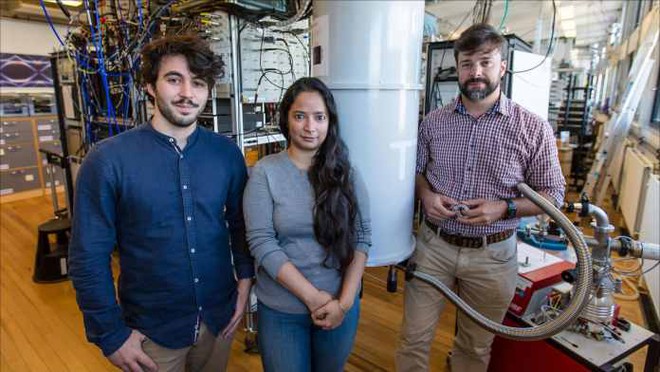Achieving a breakthrough on a microbe-like quantum chip, Danish researchers create a new lipstick milestone
- Tram Ho
Physicists working at the University of Copenhagen have announced a new achievement in the development of quantum technology. By simultaneously operating a series of spinning qubits on a quantum chip, the team has overcome an obstacle that has prevented supercomputers from becoming even more powerful. New research results have also successfully used semiconductor materials, and laid the foundation for building solid-state quantum computers.
One of the major difficulties in building a quantum computer to replace a classical one is to simultaneously control qubits – the data storage units in quantum computers. The difficulty lies in controlling the qubits, as these actions can adversely affect the control of other qubits in the same system.

In a new breakthrough, young quantum physicists at the Niels Bohr Institute of the University of Copenhagen (UCPH) have overcome a major obstacle.
The global qubit industry employs many different technologies. While Google and IBM use superconductivity in the design of quantum microprocessors, the team at UCPH uses semiconductor qubits, or rotating qubits.
” In a broad sense, they contain rotating electrons trapped in a nanoscale semiconductor structure called ‘quantum dot’, each of which can be individually dominated, entangled with other particles, ” the researcher said. Research Federico Fedele said.
The advantage of rotating qubits lies in their ability to maintain quantum states for long periods of time, potentially allowing quantum computing systems to operate faster and perform more precise math operations. In addition, the small size allows researchers to put more qubits into a chip, thereby increasing the processing power of the machine.
In the test, the UCPH team pushed up to four qubits into a chip made of the semiconductor material gallium arsenide.

Simulation of 4 qubits in a quantum chip.
Circuitry has become the main focus
Until now, quantum technology research has focused on producing more stable qubits. However, as researcher Anasua Chatterjee explains, now is the time to start shifting more resources to studying how qubits communicate with each other:
“ Our qubits are pretty good, now it’s time to wire them up so that we can run multiple qubits at the same time, while at the same time making them complex enough to be able to correct quantum computation errors. So far, studies of rotating qubits have reached the threshold of a circuit containing 2×2 or 3×3 qubits. The problem is, we still control each qubit one by one .”
And that’s where a semiconductor circuit made of gallium arsenide and about the size of a bacterium makes the difference.
“ What’s really special about our chip is that it can simultaneously control and measure all the qubits. This is unprecedented on rotating qubits or any other type of qubit, ” said researcher Chatterjee. The team’s research has been published in the journal Physical Review X Quantum.
Operating and measuring all the qubits at once will help the computer of the future perform quantum operations. Normally, if we were to measure qubits at the very end of a math operation – that is, stopping the whole system to observe the results – the fragile quantum state would immediately disintegrate. That’s why scientists find a way to measure all qubits at the same time, so that the quantum states of all qubits are off. If measured individually, just one perturbation will transform all the quantum information stored on the device.

An illustration of the qubit, the storage unit of a quantum computer.
New landmark
The creation of a new quantum circuit is an important milestone in the development of semiconductor quantum computers.
“ In order to have powerful processors, we need not only to increase the number of qubits, but also to increase the number of instructions that can be processed at the same time, which is exactly what we do ,” said Professor Kuemmeth, head of the study. new project at UCPH, commented.
According to the professor, at the moment, one of the biggest challenges is manually adjusting the chip’s 48 electrodes. Only an expert can do the heavy lifting, which is to constantly fine-tune the electrodes to suit the machine’s operating conditions. The team is trying to write an algorithm and apply machine learning to optimize this process.
In an effort to add more qubits to the chip, the team has also collaborated with other businesses to create the next generation of quantum chips. Efforts from computer science, microelectronics engineering and quantum physics will be able to take the spinning qubit to the next limit.
According to Phys.org
Source : Genk
